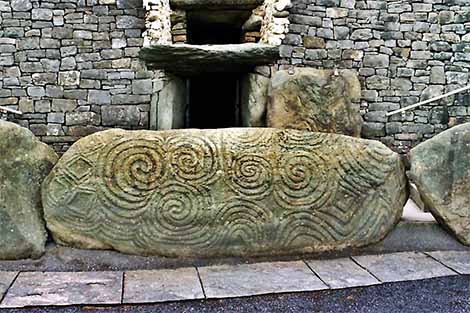Inside the Newgrange Tumulus : History, Solstice & Spirals

Newgrange - in Irish Sí an Bhrú, which means "the cave of the sun" - is a burial site, located in County Meath, Ireland. Built around 5,000 years ago, it is older than the Giza pyramids and even than the megalithic rocks of Stonehenge. It is one of the first sites which attests to the knowledge of prehistoric men in the field of astronomy.
A place of astrological worship
Newgrange is made up of megaliths, that is to say large blocks of rough stone, not cut, assembled here in a tumulus of more than 70 meters in diameter. Assuming that around three hundred people worked together to build this gigantic tomb, it is estimated that its development alone would have required at least 20 years of labor. Once in place, the exterior wall was then coated with a layer of quartzite, which is a medium grain rock. Heavily damaged over the centuries, this layer was reproduced identically after the end of the excavations.
The Newgrange site includes a corridor 17 meters long, terminated by a narrow chimney 10 centimeters high. About a week before and after the winter solstice, on December 21, the first sunrays of the day penetrate along this gallery, for 17 minutes, to finish their race on a block of stone, decorated with spirals. It was long believed, given its dimensions and the bones that was discovered there, that this block of stone was an altar intended for human sacrifices. Today, it is guessed that the dead were cremated outside the monument and their remains were later buried in Newgrange.
Spirals to symbolize a deity ?

Many Newgrange stones that do not make up the exterior wall are also provided with engraved spirals. The meaning of these spirals remains unknown, but one can assume that they symbolize a divinity. On the one hand, this would explain their frequent appearance and, on the other hand, would make it possible to interpret the course of the sun inside the gallery, provided that we admit that the builders of Newgrange, like other peoples, worshiped the sun as an autonomous divinity: taking into account the fact that the site is oriented on the course of the sun, this last supposition seems, indeed, completely plausible and presupposes that the builders had certain knowledge in astronomy. We found in Ireland and Scotland other tombs of the same period, more interesting from the architectural point of view. However, only Newgrange is oriented in this way. We can therefore conclude that the sun was of particular importance for the builders of Newgrange: for example, that it had for them divinity status.
However, Newgrange's exploration did not allow us to go beyond these simple assumptions. Indeed, although the age of this site could be established, no civilization capable of building it was known at that time. Whether inside the funerary monument or in other places, archaeologists have not discovered enough elements to tell us about this civilization and the place where it developed.
Newgrange is now open to tourism. The course of the sun during the winter solstice is artificially reproduced there for visitors.









































































































































































































































































































































